Omar Torrijos
|
Maximum Leader |
|
|---|---|
 |
|
| Maximum Leader of the Panamanian Revolution |
|
|
In office 1972 – July 31, 1981 |
|
| Preceded by | Position established |
| Succeeded by | Position abolished |
| Military Leader of Panama | |
|
In office October 11, 1968 – July 31, 1981 |
|
| President |
José María Pinilla (1968–69) Demetrio Lakas Bahas (1969–78) Aristides Royo (1978–82) |
| Preceded by | Arnulfo Arias (President) |
| Succeeded by | Florencio Flores Aguilar |
| Personal details | |
| Born |
Omar Efraín Torrijos Herrera February 13, 1929 Santiago, Panama |
| Died | July 31, 1981 (aged 52) near Penonomé, Panama |
| Political party | Democratic Revolutionary Party (1979–1981) |
| Spouse(s) | Raquel Pauzner de Torrijos |
| Occupation | Military Officer |
| Religion | Roman Catholicism |
Omar Efraín Torrijos Herrera (February 13, 1929 – July 31, 1981), more commonly known as Omar Torrijos, was the Commander of the Panamanian and National Guard and the de facto dictator of Panama from 1968 to 1981. Torrijos was never officially the president of Panama, but instead held titles including "Maximum Leader of the Panamanian Revolution" and "Supreme Chief of Government." Torrijos took power in a coup d'état and instituted a number of social reforms and his regime was considered progressive.
Torrijos is best known for negotiating the 1977 Torrijos–Carter Treaties that eventually gave Panama full sovereignty over the Panama Canal. The two treaties guaranteed that Panama would gain control of the Panama Canal after 1999, ending the control of the canal that the U.S. had exercised since 1903. On December 31, 1999, the final phase of the treaty, the US relinquished control of the Panama Canal and all areas in what had been the Panama Canal Zone.
His son Martín Torrijos was elected president and served from 2004 to 2009.
Torrijos was born in Santiago in the province of Veraguas, the sixth of eleven children. His father, José Maria Torrijos, was originally from Colombia, and was employed as a teacher. He was educated at the local Juan Demóstenes Arosemena School and, at eighteen, won a scholarship to the military academy in San Salvador. He graduated with a commission as a second lieutenant. He joined the Panamanian army, the National Guard (Guardia Nacional), in 1952. He was promoted to captain in 1956 then to major in 1960. He took a cadet course at the School of the Americas in 1965. He became the Executive Secretary of the National Guard in 1966.
...
Wikipedia
